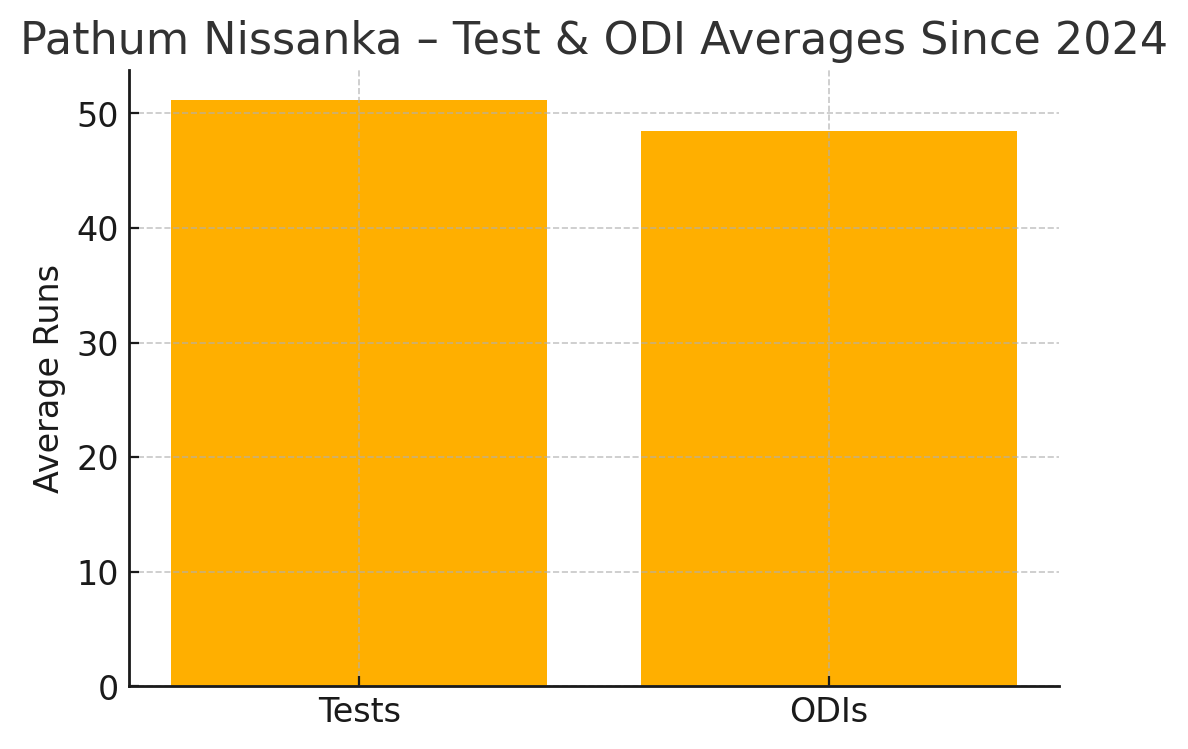Pathum Nissanka’s story is one of patience, skill, and constant growth. Born in Kalutara, cricket surrounded him from childhood. His father, a groundsman, introduced him to the game, while his mother supported the dream despite financial challenges. Early lessons with a bat laid the foundation for what has become Sri Lanka’s most exciting batting journey in years.
Nissanka’s rise was not driven by hype or shortcuts. Unlike many young talents, he built his game gradually. From Kalutara Vidyalaya to Isipathana College, and then to Badureliya Sports Club and Nondescripts Cricket Club, every step shaped his technique. His first-class record, averaging over 67, earned him a Test debut in 2021. That hundred in the West Indies marked his arrival, but the true transformation came later, like the Punjab Kings reached the finals after the Shreyas Iyer captaincy.
Since 2024, Nissanka has emerged as a genuine three-format batter. In Tests he averages over 51, while in ODIs he balances consistency with a near run-a-ball strike rate. In T20Is, his power game has developed rapidly, making him Sri Lanka’s most reliable opener. His rise is backed by data, discipline, and sheer hard work. The following sections explore his batting evolution, zone by zone, with insights, graphs, and tables.
From Defensive Stability to a Three-Format Star
Nissanka’s journey has always been about step-by-step growth. As a young cricketer, he relied heavily on his defensive technique. His patience made him ideal for longer formats, but T20s exposed his lack of scoring options. By late 2021, his ODI average had fallen below 10. Instead of fading away, he rebuilt. He began training harder, batting several sessions a day, and analyzing weaknesses with Sri Lanka Cricket’s technology.
The biggest change came in 2024. He identified scoring gaps on the off-side and leg-side and built new attacking strokes. The back-foot punch, square cut, and front-of-square pull shot became reliable weapons. His strike rate in the point region jumped from 105 to 132. His pull shot also transformed, moving from a strike rate of 164 to 233. Not only did he attempt the shot more often, but he also scored at an elite level.
This change is visible in the numbers. Nissanka now averages 51.20 in Tests, 48.47 in ODIs, and scores at a T20I strike rate of 142. His ability to adapt to formats makes him Sri Lanka’s first modern three-format opener. This consistency across formats separates him from his peers.
Nissanka’s Format-Wise Numbers Since 2024

| Format | Average | Strike Rate | Runs (T20Is) |
|---|---|---|---|
| Tests | 51.20 | – | – |
| ODIs | 48.47 | 98 | – |
| T20Is | – | 142 | 970 |
Power-Hitting and Boundary Frequency: A New Dimension
Nissanka’s power game has grown sharply in the past two years. Early in his career, he relied on timing rather than brute force. This meant fewer boundaries, which slowed his T20 scoring. But from 2024 onward, he worked on strength and power-hitting. Gym sessions improved his six-hitting ability, while practice drills improved his placement for fours.
Before 2022, Nissanka hit a six every 37 balls. Since 2024, that frequency has improved to once every 25 balls. Similarly, his fours now come every 6.1 deliveries compared to 9.9 earlier. This means bowlers can no longer keep him quiet with dot balls. His strike rotation is backed by frequent boundaries, making him a complete top-order player.
These improvements are not just numbers; they have changed matches. His 68 off 44 against Hong Kong in the Asia Cup showed his ability to mix classical shots with modern power. From lap scoops to cross-bat pulls, he can now dictate bowlers instead of only surviving them.
Boundary Frequency Comparison
| Metric | Until 2022 | Since 2024 |
|---|---|---|
| Balls per Six | 37 | 25.29 |
| Balls per Four | 9.97 | 6.1 |
The Pull Shot Evolution: From Risky to Dominant
The biggest leap in Nissanka’s batting has been his pull shot. Initially, he only played it behind square, striking at 164. By 2024, he adjusted his technique and began pulling in front of the square. His pull shot usage rose from 8.3% of deliveries to 14.6%, showing confidence and readiness to attack like in series against Bangladesh.
Today, Nissanka dominates with the pull, striking at 233 in T20Is. This makes it his most productive scoring zone. It is also a shot that unsettles fast bowlers, especially in powerplays. His ability to control and expand this stroke has given Sri Lanka quick starts, something the team lacked for years.
In a team searching for reliable openers since Dilshan and Tharanga, Nissanka’s pull shot has made him a match-winner. The data proves his transformation.
Pull Shot Improvement (T20Is)
| Metric | Until 2022 | Since 2024 |
|---|---|---|
| Pull Shot Usage % | 8.32 | 14.64 |
| Pull Shot Strike Rate | 164 | 233 |
Conclusion: The Next Stage of Pathum Nissanka’s Journey
Pathum Nissanka has proved that hard work pays off. From humble beginnings in Kalutara to becoming Sri Lanka’s most reliable opener, his growth has been steady. He has developed new shots, improved strike rates, and learned how to handle pressure at the international level. His journey is not about sudden fame but about consistent improvement.
Yet, challenges remain. While he is successful in T20Is, he has not yet dominated a big global event. The upcoming Asia Cup Super Four and the 2026 T20 World Cup will test his progress. For Sri Lanka, having an opener who can adapt across formats is priceless. Nissanka’s form will define many of their campaigns ahead.
Even now, he continues to listen to his father’s advice. That grounding keeps him humble and focused. Every step in his career has been brick by brick, and the next chapters promise even greater rewards. If he maintains this trajectory, Pathum Nissanka could become one of Sri Lanka’s finest modern batters.















